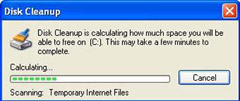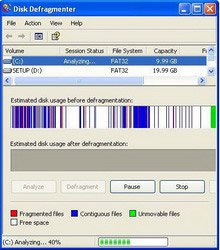5 ways to speed up Windows XP SP 2 and Windows Vista
You can optimize your computer and help it run smoothly by using the tools available in Windows XP SP2 and Windows Vista to make the system work faster and more efficiently.
Free up disk space
To improve the speed of accessing data on the hard disk, you must first free up disk space, use the Disk Cleanup tool - built into Windows - list unnecessary files for the system you have Can choose to delete some or all. Disk Cleanup will help you:

Disk Cleanup tool
- Delete temporary Internet files (caches).
- Delete program files that the system has downloaded unnecessarily (such as Microsoft ActiveX and Java applets).
- Empty the trash.
- Delete temporary Windows files.
- Delete installed programs that you have not used for too long.
Note : Internet temporary files are files that take up a lot of memory space, arising every time you access a website, helping you take less time when accessing that website in the next time. However, you should also consider before choosing to delete these files,
To use Disk Cleanup, go to Start -> All Programs -> Accessories -> System Tools -> Disk Cleanup , select the drive to free up memory space in Select Drive, and select OK . In Disk Cleanup for, you can:
- Select all files you want to delete in Files to delete .
- Remove the files you do not want to delete.
- Select OK .
Speed up data access

Disk Defragmenter
Disk Defragmenter is a Windows utility that unifies fragmented folders and files on the hard drive. You should use Disk Defragmenter several times a month or when:
- Copy a large amount of data into the system.
- Free up about 15% of the drive capacity.
- Install some new programs in the system.
To use Disk Defragmenter, click Start -> All Programs -> Accessories -> System Tools -> Disk Defragmenter -> select the drive you want to analyze -> Analyze . After the drive is analyzed, a dialog box will appear telling you whether or not the drive segment is.
- To defragment the selected drive, click Defragment .
- For details on fragmentation drives, click View Report .
Detect and fix drive errors
To optimize your PC, you can check the integrity of the files stored on the hard drive by using Error Checking Utility to check for defective sectors, scan the hard drive and corrupted system files.
If you use your computer regularly, you should run this utility once a week to prevent data loss.
To use Error Checking utility, right-click the drive you want to fix, select Properties -> Tools -> Check Now -> Scan for recovery attempts and sectors -> Start . If there are bounds of errors found, choose to fix them.
Note : If you are sure that the drive has errors, in the Check Disk dialog box, you select Automatically fix file system errors so that the system automatically fixes you.
Protect your PC from spyware programs
Since websites you visit need to enter a username and password, the spy program can install spyware on your PC, thereby collecting personal information in the drive. To retrieve information, spyware can slow down the processing speed of the system.
To kill spyware, you can use Microsoft Windows Defender built into Windows Vista or download it for Windows XP SP2. Of course, you can choose other anti-spyware software online as you like.
Take advantage of ReadyBoost in Windows Vista
If you're using Windows Vista, you can take advantage of ReadyBoost to speed up your PC. Increasing system memory capacity is always the best way to speed up the system. Many applications will be executed without having to access data from the hard drive.
ReadyBoost takes advantage of flash memory on USB or memory cards to increase memory space for the system. Flash memory will act as a system cache, making system access faster. Windows ReadyBoost is based on Windows SuperFetch's smart memory management.
Using ReadyBoost is also very simple. When a removable memory device is inserted into the PC, Windows Vista checks to see if it is capable of increasing processing speed. Finally, flash memory, a part used to cache (the capacity you choose), the rest is used to store data.
You should read it
- How to Defrag Windows 10
- How to delete a drive cannot be deleted with Disk Management
- What is RAM Disk? How does it work?
- Disk Management access in Windows 7 and Windows 8
- Create Password Reset Disk with USB Flash Drive on Windows 10
- Create Windows Password Reset Disk on Windows 7 with USB Flash Drive
- Should I use Full-Drive Compression to free up space on Windows?
- What is a disk signature? Fix disk signature conflict error
May be interested
- 10 things to do when Windows XP does not start
 when your computer hardware doesn't have a problem, but windows xp does not completely boot properly, study this article. it will show you the steps to take to solve the problem from entering the operating system, learning and 'handling' the problems that caused the machine error.
when your computer hardware doesn't have a problem, but windows xp does not completely boot properly, study this article. it will show you the steps to take to solve the problem from entering the operating system, learning and 'handling' the problems that caused the machine error. - Disrupt and save time with 10 Windows XP tips
 windows xp is no longer strange to many computer users today. however, many people do not know that in windows xp there is a tool available to create special characters to make their own mark and change the color.
windows xp is no longer strange to many computer users today. however, many people do not know that in windows xp there is a tool available to create special characters to make their own mark and change the color. - Living with Vista without XP
 speed up moves and know-how to use new features in this operating system will make windows vista more user-friendly.
speed up moves and know-how to use new features in this operating system will make windows vista more user-friendly. - Build a recovery disk for XP SP3
 can you use the original windows xp disc to restore your computer? think back to that.
can you use the original windows xp disc to restore your computer? think back to that. - Turn the interface of Vista into XP
 just a few tweaks and tips you can completely change its look to look like 'predecessor'.
just a few tweaks and tips you can completely change its look to look like 'predecessor'. - Schedule Windows XP to defragment the disk
 after a long time of using the computer, your hard drive will appear fragmented drive. defragmenting hdd is familiar to computer users.
after a long time of using the computer, your hard drive will appear fragmented drive. defragmenting hdd is familiar to computer users.






 Speed up Windows Vista
Speed up Windows Vista Living with Vista without XP
Living with Vista without XP How to Speed up Windows Vista
How to Speed up Windows Vista 10 tips to speed up Vista
10 tips to speed up Vista How to Defrag Windows Vista
How to Defrag Windows Vista